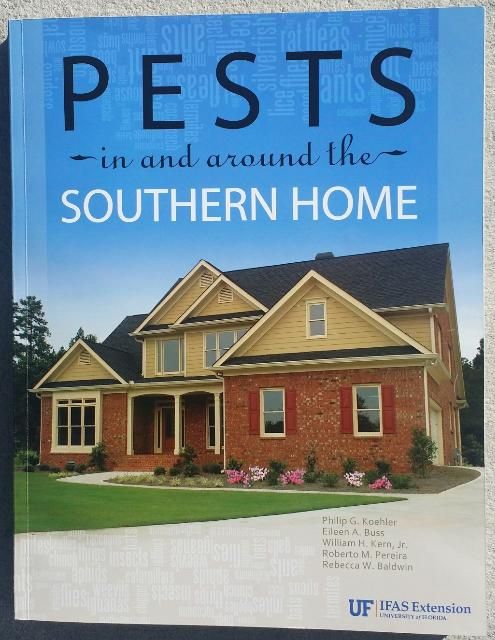
Credits: UF/IFAS
Introduction
Ants are nuisance pests around the home because they feed on and contaminate human foods, infest structures by nesting in wall voids and/or underneath kitchen sinks and other places, and build unsightly mounds in lawns and other landscapes. In some cases, ants are able to inflict painful bites or can have venomous stings. Ants do not attack or eat fabrics, leather or wood in houses. However, some species can establish nests in decaying wood, including wood in human structures.
Several species of ants are found in or around houses in Florida. In general, the most common ants can be grouped as house-infesting ants, yard-infesting ants, and carpenter ants. The most commonly encountered pest ants are pharaoh, white footed, Argentine, ghost, pyramid, carpenter, rover, native fire, imported fire, crazy, thief, Caribbean, acrobat (Figure 1), and big-headed (Figure 2) ants.
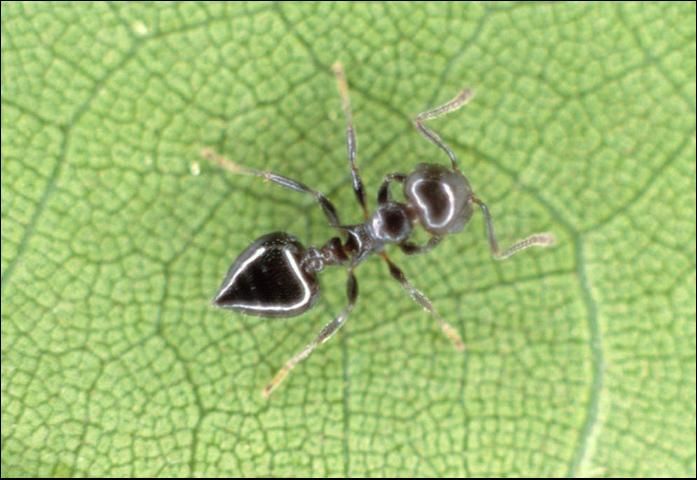
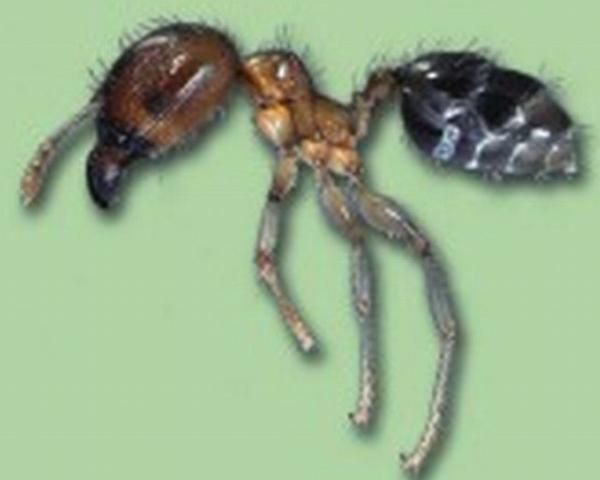

Identification
Ants can be recognized from other insects because they have a narrow waist with one or two joints (nodes) between the thorax and abdomen. When identifying ant species, the first characteristic to look at is whether the ant has one or two nodes. Also, ants have elbowed antennae. The antenna is the second most important structure in ant identification. The antenna is divided into segments starting with a long and thin segment called the scape, which is the first segment counted from the head of the ant. In some imported pest ant species, the antenna ends in a club that is formed when the last two or three segments of the antenna are significantly enlarged. Winged reproductives have four wings, with the first pair much larger than the hind pair (Figure 3).

Ants are frequently confused with termites. However, termites have a broad waist between the thorax and the abdomen. Termite reproductives have four wings of equal size (Figure 4).

Biology
Ants are social insects. Two castes (workers and reproductives — females and males) can be found in most colonies. Worker ants, which are sterile females, are rarely winged. They often are extremely variable in size and appearance within a given species (polymorphic = many forms: Figure 5), although some species have only one size of worker (monomorphic = one form), and others have two sizes (dimorphic = two forms). The functions of the worker are to construct, repair and defend the nest, and feed the immature and adult ants of the colony, including the queen. The worker ants will forage for both solid and liquid foods and water. However, most adult ants cannot ingest solid food. Solid particles are given to the larvae, which are able to digest solid particles. Some ants favor foods that are sweet, and species that are sweet feeders can be found tending to honeydew-producing homopterous insects such as aphids, mealybugs, and scale insects.
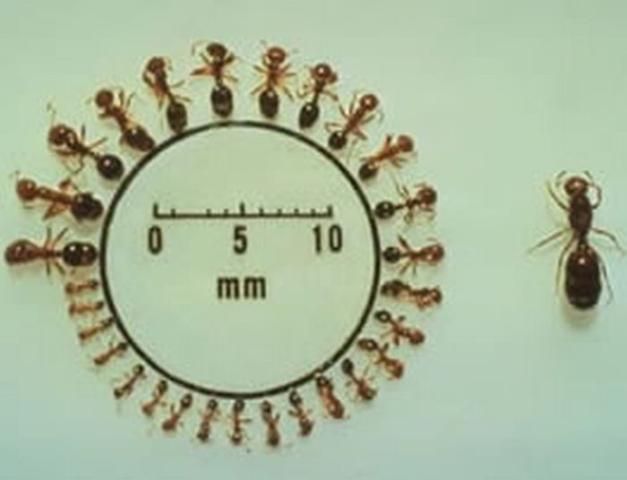
Credit: USDA-ARS
Reproductive females normally have wings but lose them after mating. Therefore, queens do not have wings. The primary function of the queen is reproduction. However, in some of the more highly specialized ants, the queen cares for and feeds the first brood of workers on her salivary secretions. The queen may live for many years, and in some species is replaced by a daughter queen. Depending on the species, ants can have one or more queens.
The male is usually winged and retains its wings until death. The sole function of the male is to mate with an unfertilized female reproductive. After mating occurs, the male dies. Males are produced in old or very large colonies where there is an abundance of food. After reaching maturity, the male usually does not remain in the colony very long.
Ants have egg, larva, pupa, and adult stages (Figure 6). Eggs are almost microscopic and hatch into soft, legless larvae. Larvae are fed by workers, usually on predigested, regurgitated food. This process of exchanging food is called trophallaxis. Most larvae are fed liquids, although some older larvae are able to chew and digest solids. The pupa resembles the adult except that it is soft, uncolored, and immobile. In many ant species the pupa is in a cocoon spun by the larva. Six weeks to two months are required for development from egg to adult in some species.

Credit: CDFA.CA.GOV
Ants establish new colonies by two main methods: flights of winged reproductives and budding. The most common method is for male and female reproductives to leave the nest on mating flights (nuptial flights). The several hundred to thousands of winged reproductives that emerge from colonies for their nuptial flights have also been termed as "swarming." These ant swarms in early spring can lead to increased frantic homeowner calls to pest management professionals. The mating flights are usually triggered by weather cues such as the right temperature and/or 24 hours after a rainstorm. The mated queen constructs a cavity or cell and rears a brood unaided by workers. The first brood molts into small workers, which then forage for food and take over the brood-caring and other duties in the nest while the queen continues to lay eggs. The colony grows in size and numbers as more young are produced. The colony grows rapidly but slows its growth when the colony size nears maturity.

Budding occurs when one or more queens leave the nest accompanied by workers who aid in establishing and caring for the new colony. Some of the most difficult ant species to control spread colonies by budding. Pharaoh ants (Figure 7), some kinds of fire ants (Figure 8), ghost ants (Figure 9), and Argentine ants (Figure 10) spread colonies by budding.



Food Preferences
Most ants eat a wide variety of foods, although some have specialized tastes. Fire ants feed on honeydew, sugars, proteins, oils, seeds, plants, and insects. Pharaoh ants (Figure 7) feed on sugars, proteins, oils, and insects. Crazy ants (Figure 11) like sugars, protein, and insects. Carpenter ants prefer sugars and insects. Often ants' preference for certain foods will vary throughout the year depending on how much brood is being produced in the nest. This variance in food preference has some consequence on the use of baits for ant control. Sometimes changing from sugar-based baits to protein or oil-based baits may be important in maintaining the ants' interest in the toxic baits.

Ants use scouts to locate food. When a scouting ant finds promising food, she carries it or a piece of it back to the nest. Some ants leave scent trails composed of various chemical compounds known as pheromones that others can follow to the food source. The pheromone trail that is deposited by scout ants is typically short-lived and must be reapplied continuously. Ants require water and will travel some distance for it if necessary. Workers are able to bring water to the colony in their guts.
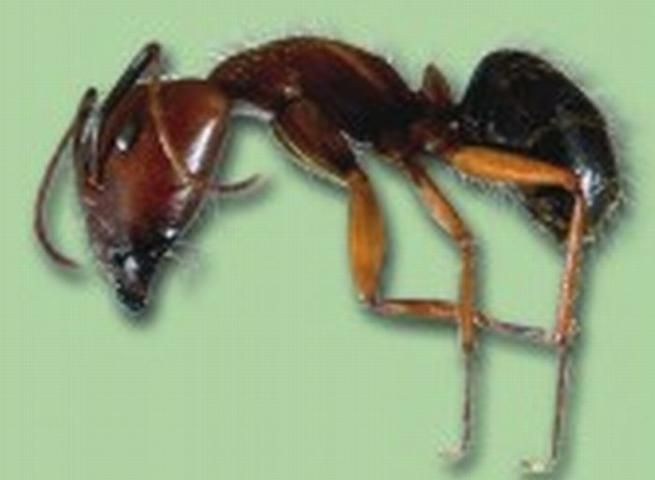
Despite their name and where they are found, Florida carpenter ants (Figure 12) do not eat wood (as is the case with termites), but excavate galleries in it to rear their young. Carpenter ants feed on honeydew from sucking insects, household food scraps, insects, and other foods. They do not damage sound wood to any extent.
Control
Prevention
Prevention is the best line of defense against the establishment of any pest insect. Relatively small ants, such as the white-footed ant (Figure 13) and rover ant (Figure 14), can fit through extremely small openings to gain access into the home. Sealing cracks and holes where ants may be entering a structure can effectively stop most ant invasions. If these entry points can be located, they can be blocked by application of caulk or some other exclusion device. This can also help to prevent other insects from gaining access into your home.

The best approach to ant control in the home is cleanliness. Any type of food or food particles can attract and provide food for ants. Store food in tight containers. Remove plants that can attract ants, or control aphids, whiteflies and other honeydew-producing insects on plants in and around structures. Removing any materials or vegetation that is serving as a nesting site to ants is beneficial towards a long-term ant management strategy. Try to remove piles of old lumber, firewood, railroad ties, and debris that can serve as potential nesting sites for many ants including Argentine, Caribbean crazy, crazy, white-footed, and fire ants. Reduce moisture sources, including condensation and leaks.

Credit: Credit: Alexander Wild
Inspection
Finding the nest is the key to control because ants are social insects. The time taken in performing a proper inspection by locating all areas where ants are active is crucial for a successful ant management program. If the nest is not found, large numbers of individual ants can be killed without ever solving the problem. Determine the kind of ant infestation so control actions can be selected properly. Most species of ants never enter buildings; others build their nests near buildings and forage indoors. Others usually nest indoors.
Keep a record of where ants have been seen. Some ants follow definite trails. If possible, follow these trails to the nest. Placement of attractive materials, such as jelly, oils, protein, and other materials can attract large numbers of ants so they can be followed to their nest.
Outdoors, ant nests can often be located by seeing ant hills on the ground. Some ants deposit earth near or around the nest entrance on the soil surface when they construct the nest. Fire ants and certain other ants build conspicuous mounds (Figure 15). Nests may also be constructed next to or under the house foundation, under sidewalks, driveways and patios, or in decaying logs or tree trunks.

Indoors, ants may nest in walls, behind a baseboard or under the house. Often ant trails enter through a crack, but the nest may be some distance away. Some ants may also nest in decayed or rotting wood in the house (Figure 16).

Credit: L. Hansen and R. Akre
Chemical Control
Ants can be controlled with baits, crack-and-crevice treatments, indoor space-and-surface treatments, and outdoor barrier and broadcast treatments, as well as void and attic treatments. However, methods that target individual trails of ants such as crack-and-crevice treatments and indoor space-and-surface treatments are usually a "quick fix" and ineffective in the long term because they do not significantly reduce the ant population and do not affect the queen.
Ant baits, however, were developed to exploit the foraging and nestmate feeding behaviors of ants. Baits are the most effective way to get toxicant into the nest. Bait treatments are effective for control of many ant species and are available in homeowner and professional product versions. Since ants rely heavily on trophallaxis (reciprocal feeding), the bait toxicant can be thoroughly distributed to the members of the colony, including the queen and brood. Baits are effective because they not only kill the foraging members of the colony, but they kill the queen(s) so no other ants are produced. Place bait next to nests whenever possible, but avoid placing bait in areas where it can be found by small children. Bait is most successful if it does not compete with other food sources in or around buildings, so combine baiting with sanitation practices.
The ideal bait contains a slow-acting, nonrepellent toxicant that is incorporated into a preferred food substrate. There are many types of baits on the market. Baits may contain:
- Insect growth regulators that primarily impact brood production and development;
- metabolic inhibitors that primarily kill the foraging workers, the brood and queen.
- In general, ant baits can be found as:
- Granules for broadcast;
- liquids;
- gels; and
- ready-to-use, tamper-resistant containers.
Both granules and liquids can be used in specially designed stations. Liquids are usually prepackaged for use or come as part of a system that uses a bait station. Gel baits usually come prepackaged in large syringes for crack-and-crevice treatments.
For large areas, the most efficient management method is to broadcast bait with a granular. Granular ant baits can be broadcast in the landscape around structures and in lawns. Most granular baits that are labeled for broadcast use are also labeled for individual mound or nest treatments.
Use the following guidelines for successful baiting with granular products:
- Use fresh bait. If the bait is not fresh, ants will be less likely to eat it. Ants must eat the bait in order to be effective. If the bait smells like rancid oil or stale potato chips, the bait is spoiled.
- Wash your hands before baiting to prevent contamination from other products.
- Do not smoke while baiting. The nicotine will contaminate the bait.
- Timing of the application is as important as the choice of control. Granular broadcast applications should be done in good weather. A good rule of thumb is to bait on a day that you would have a picnic; about 70°F - 90°F (21°C - 32°C) and not immediately before or after a drenching rain. Also, turn off any irrigation for a few hours before and after baiting.
- Bait after the dew, rain, or irrigation has dried. Water can ruin most baits.
- Bait where you see the ants foraging.
- Store bait in an airtight container and place in a cool dry place, away from other pesticides or potential contaminants.
Gel baits are particularly useful in crack-and-crevice treatments. In all cases of bait use, do not spray any insecticides around the bait application. Sprays are repellent, and if they contaminate the bait the bait treatment will be ineffective because the ants will not eat it.
Sweet baits are effective for many sweet-feeding ant species. However, they provide control only if ants ingest them. Management of some ant species has been accomplished by treating infested homes exclusively with baits that contain boric acid. A 1 percent boric acid concentration in sugar water seems to be effective. However, a large amount of bait may need to be dispensed and made available to ants over several weeks. If ants are nesting outdoors, baits may need to be placed outside of the structure rather than indoors.
Residual insecticide sprays applied outside the home as a barrier can provide temporary relief from invading ants. Ants that cross the barrier do not die immediately, but at some point they will die and carcasses may be found within the home. In addition, foraging and nesting ants in the landscape should be treated. For example, if ants are observed moving up and down the trunk of a tree, the trunk should be treated. After the effectiveness of the chemical barrier has subsided, ants may reestablish foraging inside.
For heavy infestations, we recommend the Florida 3-Step Program:
- Treat the perimeter with a repellent liquid or granular insecticide.
- Broadcast bait with the appropriate product for your ant problem.
- Individually treat remaining infestations, whether they are indoor or outdoor, such as fire ant mounds.